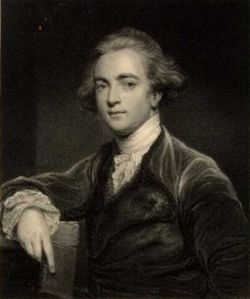William Jones (philologist)
Sir William Jones (September 28, 1746 – April 27, 1794) was an English philologist and student of ancient India, particularly known for his proposition of the existence of a relationship among Indo-European languages.
Jones was born at Beaufort Buildings, Westminster; his father (also named Sir William Jones) was a mathematician. The young William Jones was a linguistic prodigy, learning Greek, Latin, Persian, Arabic and the basics of Chinese writing at an early age. By the end of his life he knew thirteen languages thoroughly and another twenty-eight reasonably well, making him a hyperpolyglot.
Though his father died when he was only three, Jones was still able to go to Harrow and on to university. He graduated from University College, Oxford in 1764. Too poor, even with his award, to pay the fees, he gained a job tutoring seven-year-old Earl Spencer, son of Lord Althorp and as such an ancestor of Princess Diana. He embarked on a career as a tutor and translator for the next six years. During this time he published Histoire de Nader Chah, a French translation of a work originally written in Persian done at the request of King Christian VII of Denmark who had visited Jones - who by the age of 22 had already acquired a reputation as an orientalist. This would be the first of numerous works on Persia, Turkey, and the Middle East in general.
For three years beginning in 1770 he studied law, which would eventually lead him to his life-work in India; after a spell as a circuit judge in Wales, and a fruitless attempt to resolve the issues of the American Revolution in concert with Benjamin Franklin in Paris, he was appointed to the Supreme Court of Bengal in 1783.
In the Subcontinent he was entranced by Indian culture, an as-yet untouched field in European scholarship, and founded the Asiatic Society of Bengal. Over the next ten years he would produce a flood of works on India, launching the modern study of the subcontinent in virtually every social science. He also wrote on the local laws, music, literature, botany, and geography, and made the first English translations of several important works of Indian literature.
Contributions
Of all his discoveries, Jones is best known today for making and propagating the observation that Sanskrit bore a certain resemblance to classical Greek and Latin. In The Sanscrit Language (1786) he suggested that all three languages had a common root, and that indeed they may all be further related, in turn, to Gothic and the Celtic languages, as well as to Persian.
His third discourse (delivered in 1786 and published in 1788) with the famed "philologer" passage is often cited as the beginning of comparative linguistics and Indo-European studies. This is Jones' most quoted passage, establishing his tremendous find in the history of linguistics:
The Sanscrit language, whatever be its antiquity, is of a wonderful structure; more perfect than the Greek, more copious than the Latin, and more exquisitely refined than either, yet bearing to both of them a stronger affinity, both in the roots of verbs and the forms of grammar, than could possibly have been produced by accident; so strong indeed, that no philologer could examine them all three, without believing them to have sprung from some common source, which, perhaps, no longer exists.
Although as early as the mid-17th century Dutchman Marcus Zuerius van Boxhorn (1612–1653) and others had been aware that Ancient Persian belonged to the same language group as the European languages, and, publishing in 1787, American colonist Jonathan Edwards Jr. demonstrated, with supporting data (which Jones lacked), that Algonquian and Iroquoian language families (families not merely languages) were related, it was Jones' discovery that caught the imagination of later scholars and became the semi-mythical origin of modern historical comparative linguistics.
Jones is also indirectly responsible for some of the feel of the English Romantic movement's poetry (including the likes of Lord Byron and Samuel Taylor Coleridge), as his translations of "eastern" poetical works were a source for that style.
ReferencesISBN links support NWE through referral fees
- Campbell, Lyle. (1997). American Indian languages: The historical linguistics of Native America. New York: Oxford University Press. ISBN 0-19-509427-1.
- Cannon, Garland H. (1964). Oriental Jones: A biography of Sir William Jones, 1746-1794. Bombay: Asia Pub. House Indian Council for Cultural Relations.
- Cannon, Garland H. (1979). Sir William Jones: A bibliography of primary and secondary sources. Amsterdam: Benjamins. ISBN 90-272-0998-7.
- Cannon, Garland H.; & Brine, Kevin. (1995). Objects of enquiry: Life, contributions and influence of Sir William Jones. New York: New York University Press. ISBN 0-8147-1517-6.
- Franklin, Michael J. (1995). Sir William Jones. Cardiff: University of Wales Press. ISBN 0-7083-1295-0.
- Jones, William, Sir. (1970). The letters of Sir William Jones. Cannon, Garland H. (Ed.). Oxford: Clarendon Press. ISBN 0-19-812404-X.
- Mukherjee, S. N. (1968). Sir William Jones: A study in eighteenth-century British attitudes to India. London, Cambridge University Press. ISBN 0-521-05777-9.
- Poser, William J. and Lyle Campbell (1992). Indo-european practice and historical methodology, Proceedings of the Eighteenth Annual Meeting of the Berkeley Linguistics Society, pp. 214-236.
- The 1911 Encyclopedia Britannica, 11th ed. Sir William Jones
Credits
New World Encyclopedia writers and editors rewrote and completed the Wikipedia article in accordance with New World Encyclopedia standards. This article abides by terms of the Creative Commons CC-by-sa 3.0 License (CC-by-sa), which may be used and disseminated with proper attribution. Credit is due under the terms of this license that can reference both the New World Encyclopedia contributors and the selfless volunteer contributors of the Wikimedia Foundation. To cite this article click here for a list of acceptable citing formats.The history of earlier contributions by wikipedians is accessible to researchers here:
The history of this article since it was imported to New World Encyclopedia:
Note: Some restrictions may apply to use of individual images which are separately licensed.
